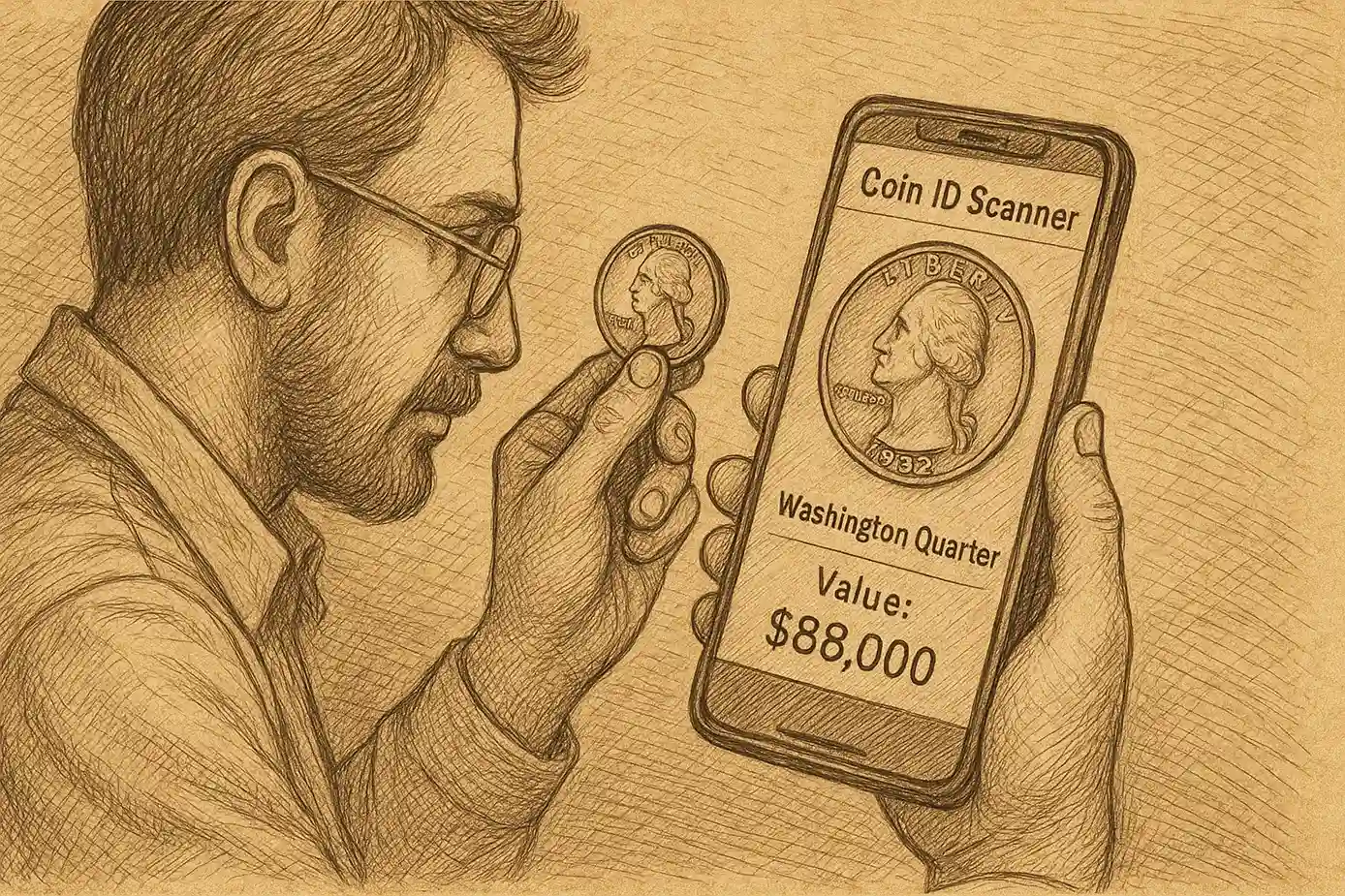Have you ever dumped a handful of coins from your pocket onto the kitchen counter and glanced over the quarters? You probably didn’t give them much thought or thought about how many quarters in a roll can grab your attention. After all, they’re just common currency—useful for parking meters and vending machines. But what if one of those coins was secretly worth hundreds, thousands, or even millions of dollars?
Here’s a wild fact: millions of valuable quarters are still in circulation.
They might be hiding in:
- The change you received from a coffee shop.
- An old coin jar in your grandparent’s attic.
- The back of your junk drawer or glove compartment.
This is why seasoned collectors always say: “Check your change.” It’s the easiest, lowest-cost entry point into the hobby — and it could lead to a windfall.
Welcome to the fascinating world of rare quarters—a space where casual finders turn into collectors and every coin tells a story. Let’s dive into why some quarters are unexpectedly valuable and what makes them so desirable.

Why Some Quarters Are Worth More
At first glance, all quarters look pretty similar: a silver-colored disc featuring George Washington on the obverse, some form of design or eagle on the reverse, and a mint year. But behind those surface details lies a rich ecosystem of coin grading, minting anomalies, and historical rarity that can elevate a simple 25-cent piece into a prized possession for collectors worldwide.
Here are the primary reasons a quarter might be worth more than face value:
🟢 1. Low Mintage Numbers
When fewer coins are produced in a specific year or at a certain mint location, scarcity drives demand. Think of it like a limited-edition print — the fewer there are, the more people are willing to pay.
🟢 2. Historical Significance
Quarters from early U.S. history or those that reflect pivotal moments in American culture carry intrinsic value for historians and numismatists alike.
🟢 3. Minting Errors
A coin struck off-center, missing elements, or created with incorrect metals can become a rare and highly desirable “error coin.” These often fetch the highest prices in auctions.
🟢 4. Precious Metal Content
Some quarters, particularly commemorative ones, were struck in silver instead of the standard copper-nickel alloy. The metal alone can make the coin valuable — and that’s before any historical or rarity factors are considered.
The Anatomy of a Valuable Quarter
Every valuable quarter has specific traits that differentiate it from its ordinary counterparts. By focusing on these core identifiers, you can quickly assess whether a quarter is potentially worth something significant.
Here are the four major markers to examine:
🟠 1. Mint Mark
The mint mark indicates where the coin was produced. It’s a small letter (such as “D,” “S,” or “P”) located on the obverse or reverse of the quarter depending on the year. Some of the most valuable quarters were minted in San Francisco (S) or Denver (D) due to lower production numbers.
🟠 2. Mint Year
Certain years—especially those with historically low mintages or major design changes—can signal a rare issue. For example:
- 1932-S and 1932-D are both key years in the Washington Quarter series.
- 1916 is the first and rarest year of the Standing Liberty Quarter.
- 1976 silver-clad Bicentennial quarters are highly collectible.
🟠 3. Design Details
Even small design shifts, such as the position of Liberty’s head or the presence of arrows beside the date, can make a major difference in a coin’s value. Compare your quarter to high-resolution images from trusted numismatic resources to detect these subtle but important features.
🟠 4. Condition (Grade)
The better the condition, the higher the price. Grading ranges from Good (G) to Mint State (MS) and Proof (PR). Quarters that are shiny, untarnished, and show no signs of wear or scratches are far more desirable to collectors.
Coin ID Scanner: Your Digital Coin Expert
Gone are the days when coin identification meant lugging around a thick guidebook. Today, even novice collectors have access to powerful tools that bring professional-level insights right to their smartphone. The most versatile and accessible tool in this space is the Coin ID Scanner app.

What it does:
This free, AI-powered app allows users to snap a photo of any coin and instantly receive a full identification report. This includes the coin’s name, mint year, place of origin, metal composition, rarity status, and current estimated market value.
Key features include:
- 📸 Instant Image Recognition — Just take a photo and let the app analyze your coin.
- 🧠 AI-Powered Matching — Compares your coin against a database of over 150,000 verified coins.
- 📊 Market Value Tracking — Get real-time estimates of your coin’s worth.
- 📂 Collection Management — Organize, sort, and value your coin collection all in one place.
Whether you’re scanning coins from your pocket change or cataloging an inherited collection, the Coin ID Scanner app is a must-have utility that saves time, prevents costly mistakes, and boosts your confidence in spotting valuable pieces.
Real Quarters That Are Worth Real Money
Below is a table of quarters that have turned heads at auctions and collector markets, along with a summary of what makes each one special:
| Quarter | Year | Why It’s Valuable | Estimated Value |
| 1932-S Washington | 1932 | Low mintage: only 408,000 made | Up to $88,000 |
| 1976 Bicentennial (Silver Error) | 1975–1976 | Special 40% silver version with mint errors | Up to $388,000 |
| 1916 Standing Liberty | 1916 | Only 52,000 minted, first of its kind | Over $88,000 |
| 1796 Draped Bust | 1796 | First U.S. quarter ever made | $10,000–$1,000,000+ |
| 1870-CC Seated Liberty | 1870 | Carson City mint, just 8,340 struck | $150,000+ |
These values reflect coins in near-mint or uncirculated condition, but even well-worn examples can hold substantial value.
Smart Strategies for Starting (or Expanding) Your Collection
Whether you’re just beginning or already knee-deep in numismatic research, these time-tested practices will help you build a smart and sustainable collection.
🔹 1. Define Your Focus
Collecting quarters can take many forms:
- By year (e.g., every Washington Quarter from 1932 to present)
- By mint (e.g., only Denver or San Francisco coins)
- By theme (e.g., state quarters, America the Beautiful series)
- By rarity (hunting for low-mintage or error coins)
A defined collecting goal helps narrow your search and creates a more rewarding experience.
🔹 2. Track Everything Digitally
Use the Coin ID Scanner app not only to identify but also to catalog your collection. With features like value tracking, coin condition tags, and photo logs, it becomes your personal coin inventory manager. You’ll always know what you own, what it’s worth, and what’s missing from your collection.
🔹 3. Buy (and Sell) With Caution
If you’re buying quarters from sellers, ensure:
- You understand the current fair market value using reference tools like the Coin ID Scanner or PCGS Price Guide
- The coin is authenticated or graded by trusted third parties like PCGS or NGC
- You’re using reputable marketplaces such as Heritage Auctions, eBay (with caution), or GreatCollections
For sellers: Always document your coin’s condition and grading certificate to fetch the best price and protect against disputes.
How to Protect Your Coin Collection
Coins can lose value if mishandled or exposed to damaging conditions. Here’s how to keep your quarters in top shape:
| Risk Factor | How to Prevent It |
| Oxidation/Tarnish | Store coins in airtight holders or Mylar flips. |
| Physical Damage | Avoid cleaning coins; use cotton gloves when handling. |
| Environmental Harm | Keep the collection in cool, dry places away from sunlight. |
| Misplacement | Use digital logs like the Coin ID Scanner to track inventory and storage locations. |
If you plan to invest long-term, consider insuring high-value coins through specialty collectibles insurance providers.
Rare quarters are not just metal. They are pieces of history: minted during wars, political changes, and cultural shifts. They carry marks, imperfections, and details that make them unique—and potentially extremely valuable.
Here’s what you should remember:
- Check every quarter you come across—you never know when a $0.25 coin could be worth $25,000.
- Use modern tools like the Coin ID Scanner to instantly analyze, catalog, and price-check your finds.
- Protect your collection like a real investment—because that’s exactly what it can become.
Whether you’re a weekend hobbyist or a serious numismatist, now is the perfect time to start searching, collecting, and discovering the quarters that cost more than you think.


